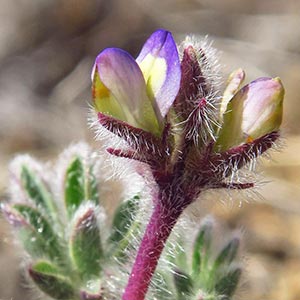|
sand lupine, short stem blue lupine, short-stem lupine
|
narrow flower lupine
|
| Herbs, annual, usually less than 1 dm, pubescent, hairs more than 1 mm. |
Herbs, perennial, 5–12 dm, green, glabrous or sparsely hairy. |
very short, tufted, branched. |
ascending-erect, branched. |
cauline, crowded near base; stipules well developed; petiole 1–6 cm; leaflets (3 or)5–9, blades 8–20 × 2–9 mm, adaxial surface glabrous. |
cauline; stipules 5–13 mm; petiole 1–5 cm; leaflets 6–9, blades 20–60 × 4–8 mm, adaxial surface glabrous or with scattered hairs. |
dense, 3–16-flowered, 1–8 cm; flowers spirally arranged, crowded. |
open, 6–34 cm; flowers spirally arranged. |
1–8(–10) cm; bracts persistent, straight, 2–3 mm. |
1–8 cm; bracts ± persistent, 3–7 mm. |
0.3–1.5 mm. |
2–4 mm. |
6–8 mm; calyx abaxial lobe entire or shallowly cleft, ± 6 mm, adaxial lobe 2-toothed, 3 mm, less than 1/2 as long as abaxial; corolla bright blue, banner spot white or yellow, keel glabrous. |
8–10(–12) mm; calyx bulge or spur 0–1 mm, abaxial lobe entire or 3-toothed, 4–9 mm, adaxial lobe 2-toothed, 4–8 mm; corolla usually pale yellow to orange-yellow, sometimes white, banner patch orange to yellow, keel tip pale lavender, banner usually hairy abaxially, keel glabrous. |
not undulate, 1 cm, thinly pilose to coarsely hirsute. |
2.5–4 cm, hairy. |
persistent, disclike, sessile. |
deciduous, petiolate. |
1 or 2, smooth. |
1–4, speckled tan and brown, 4.5–5.5 mm. |
|
|
|
|
| Flowering spring. |
Flowering Jun–Sep. |
| Sandy washes, open areas, grasslands, pinyon pine-juniper forests, creosote bush scrub, mesquite. |
Volcanic soils. |
| 300–2400 m. (1000–7900 ft.) |
1000–3500 m. (3300–11500 ft.) |
|
AZ; CA; CO; NM; NV; OR; UT; WY; Mexico (Chihuahua, Sonora)
|
CA
|
Lupinus brevicaulis resembles L. flavoculatus except that its flowers are smaller. (Discussion copyrighted by Flora of North America; reprinted with permission.) |
Lupinus angustiflorus is known from the High Cascade Range, the northern and central High Sierra Nevada, and the Great Basin region of northeastern California. It is usually found on volcanic soils associated with yellow pine, red fir, lodgepole pine, and mountain hemlock forests. In Mono County, it is more commonly associated with sagebrush, bitterbrush, rabbitbrush, and wax currant. The persistent bracts, yellow flowers, and abaxial pubescence on the banner clearly separate this taxon from other species. (Discussion copyrighted by Flora of North America; reprinted with permission.) |
| FNA vol. 11. |
FNA vol. 11. |
| Fabaceae > subfam. Faboideae > Lupinus |
Fabaceae > subfam. Faboideae > Lupinus |
L. adsurgens, L. affinis, L. albicaulis, L. albifrons, L. andersonii, L. angustiflorus, L. antoninus, L. apertus, L. arboreus, L. arbustus, L. arcticus, L. argenteus, L. arizonicus, L. benthamii, L. bicolor, L. breweri, L. cervinus, L. chamissonis, L. citrinus, L. concinnus, L. constancei, L. covillei, L. croceus, L. dalesiae, L. diffusus, L. duranii, L. elatus, L. elmeri, L. excubitus, L. flavoculatus, L. formosus, L. fulcratus, L. gracilentus, L. grayi, L. guadalupensis, L. havardii, L. hirsutissimus, L. huachucanus, L. hyacinthinus, L. kingii, L. kuschei, L. lapidicola, L. latifolius, L. lepidus, L. leucophyllus, L. littoralis, L. longifolius, L. ludovicianus, L. luteolus, L. magnificus, L. malacophyllus, L. microcarpus, L. nanus, L. neomexicanus, L. nevadensis, L. nipomensis, L. nootkatensis, L. obtusilobus, L. odoratus, L. onustus, L. oreganus, L. pachylobus, L. padrecrowleyi, L. peirsonii, L. perennis, L. polyphyllus, L. pratensis, L. pusillus, L. rivularis, L. sabineanus, L. sericatus, L. sericeus, L. shockleyi, L. sierrae-blancae, L. sparsiflorus, L. spectabilis, L. stiversii, L. subcarnosus, L. succulentus, L. sulphureus, L. texensis, L. tidestromii, L. tracyi, L. truncatus, L. uncialis, L. villosus, L. westianus |
L. adsurgens, L. affinis, L. albicaulis, L. albifrons, L. andersonii, L. antoninus, L. apertus, L. arboreus, L. arbustus, L. arcticus, L. argenteus, L. arizonicus, L. benthamii, L. bicolor, L. brevicaulis, L. breweri, L. cervinus, L. chamissonis, L. citrinus, L. concinnus, L. constancei, L. covillei, L. croceus, L. dalesiae, L. diffusus, L. duranii, L. elatus, L. elmeri, L. excubitus, L. flavoculatus, L. formosus, L. fulcratus, L. gracilentus, L. grayi, L. guadalupensis, L. havardii, L. hirsutissimus, L. huachucanus, L. hyacinthinus, L. kingii, L. kuschei, L. lapidicola, L. latifolius, L. lepidus, L. leucophyllus, L. littoralis, L. longifolius, L. ludovicianus, L. luteolus, L. magnificus, L. malacophyllus, L. microcarpus, L. nanus, L. neomexicanus, L. nevadensis, L. nipomensis, L. nootkatensis, L. obtusilobus, L. odoratus, L. onustus, L. oreganus, L. pachylobus, L. padrecrowleyi, L. peirsonii, L. perennis, L. polyphyllus, L. pratensis, L. pusillus, L. rivularis, L. sabineanus, L. sericatus, L. sericeus, L. shockleyi, L. sierrae-blancae, L. sparsiflorus, L. spectabilis, L. stiversii, L. subcarnosus, L. succulentus, L. sulphureus, L. texensis, L. tidestromii, L. tracyi, L. truncatus, L. uncialis, L. villosus, L. westianus |
|
L. andersonii var. christinae, L. christinae |
| S. Watson: Botany (Fortieth Parallel), 53, plate 7, figs. 1–4. (1871) |
Eastwood: Leafl. W. Bot. 2: 226. (1940) |
| |


